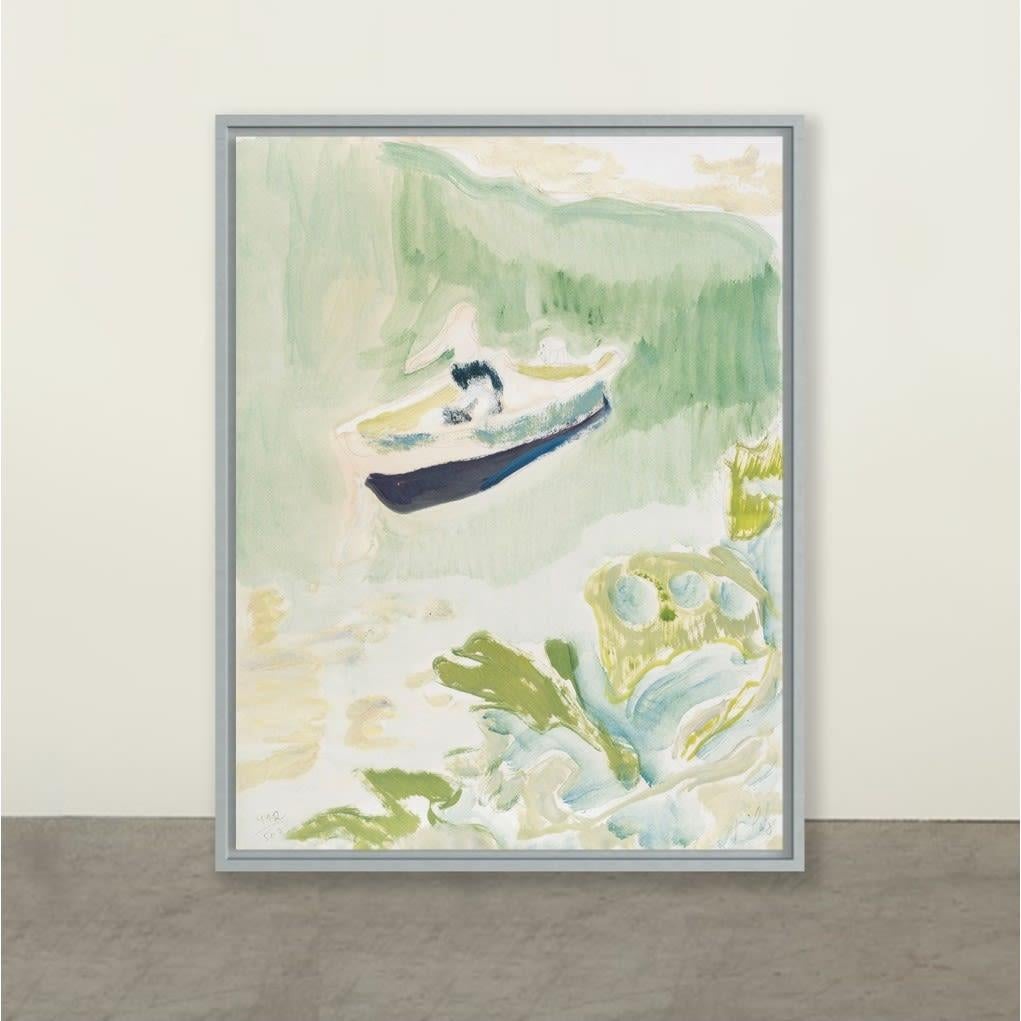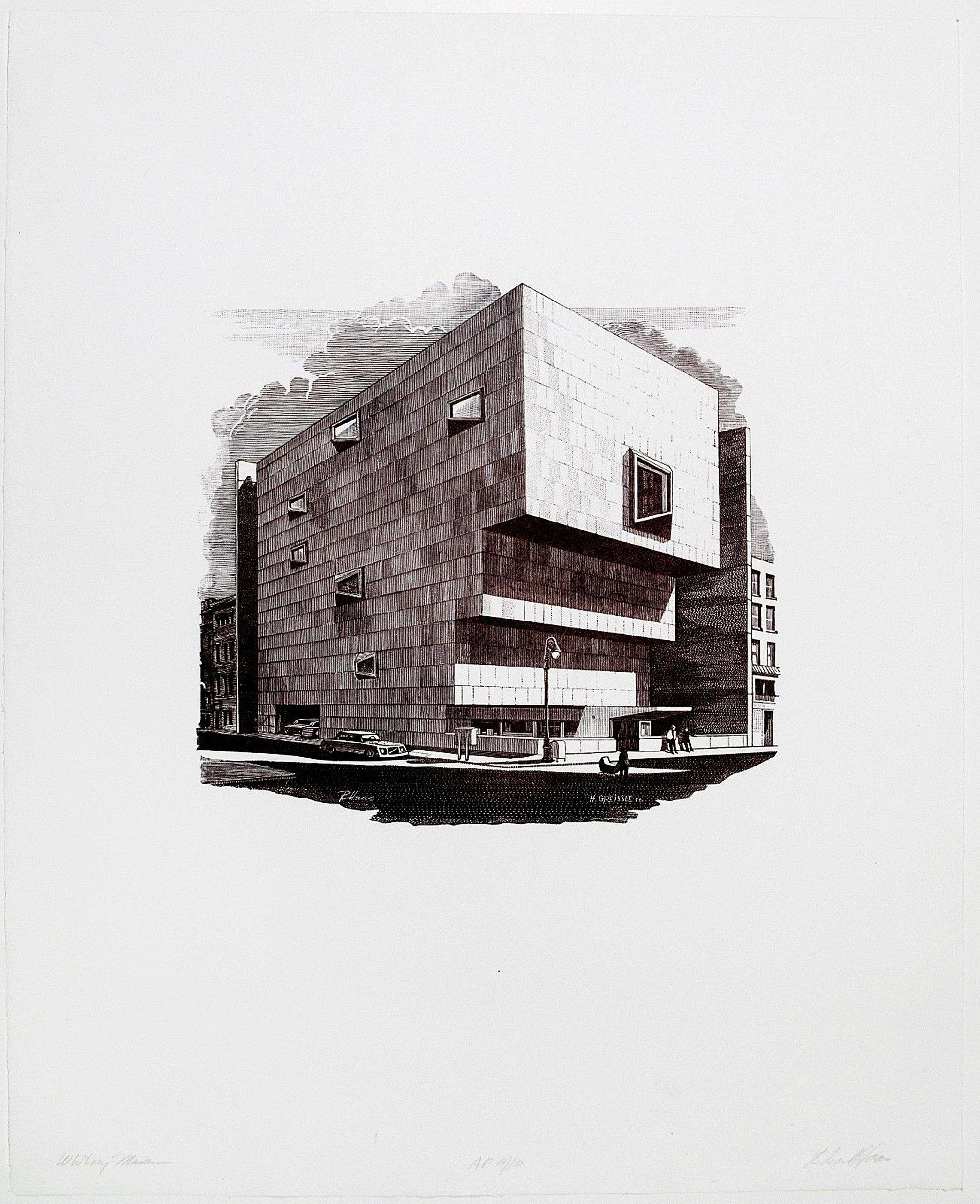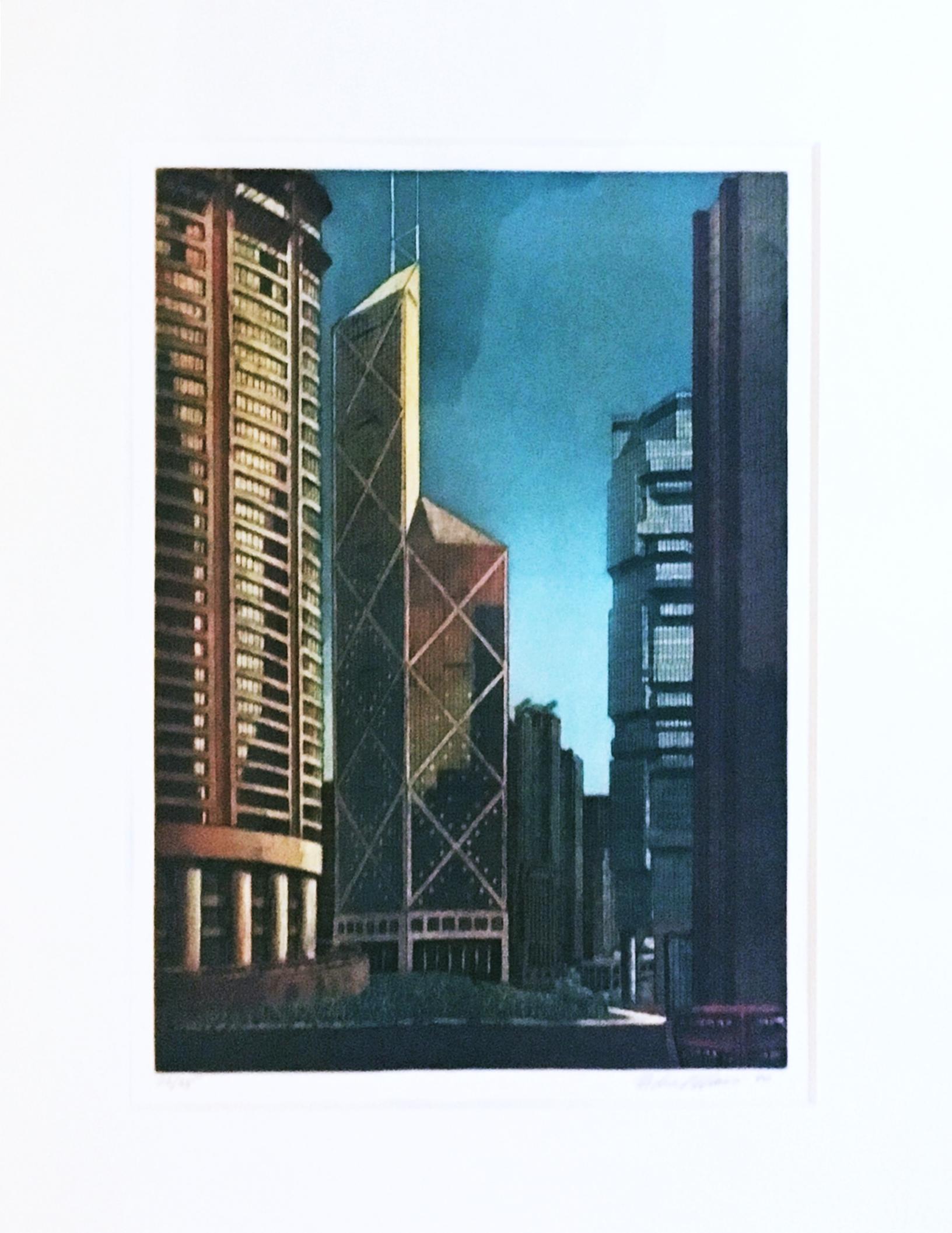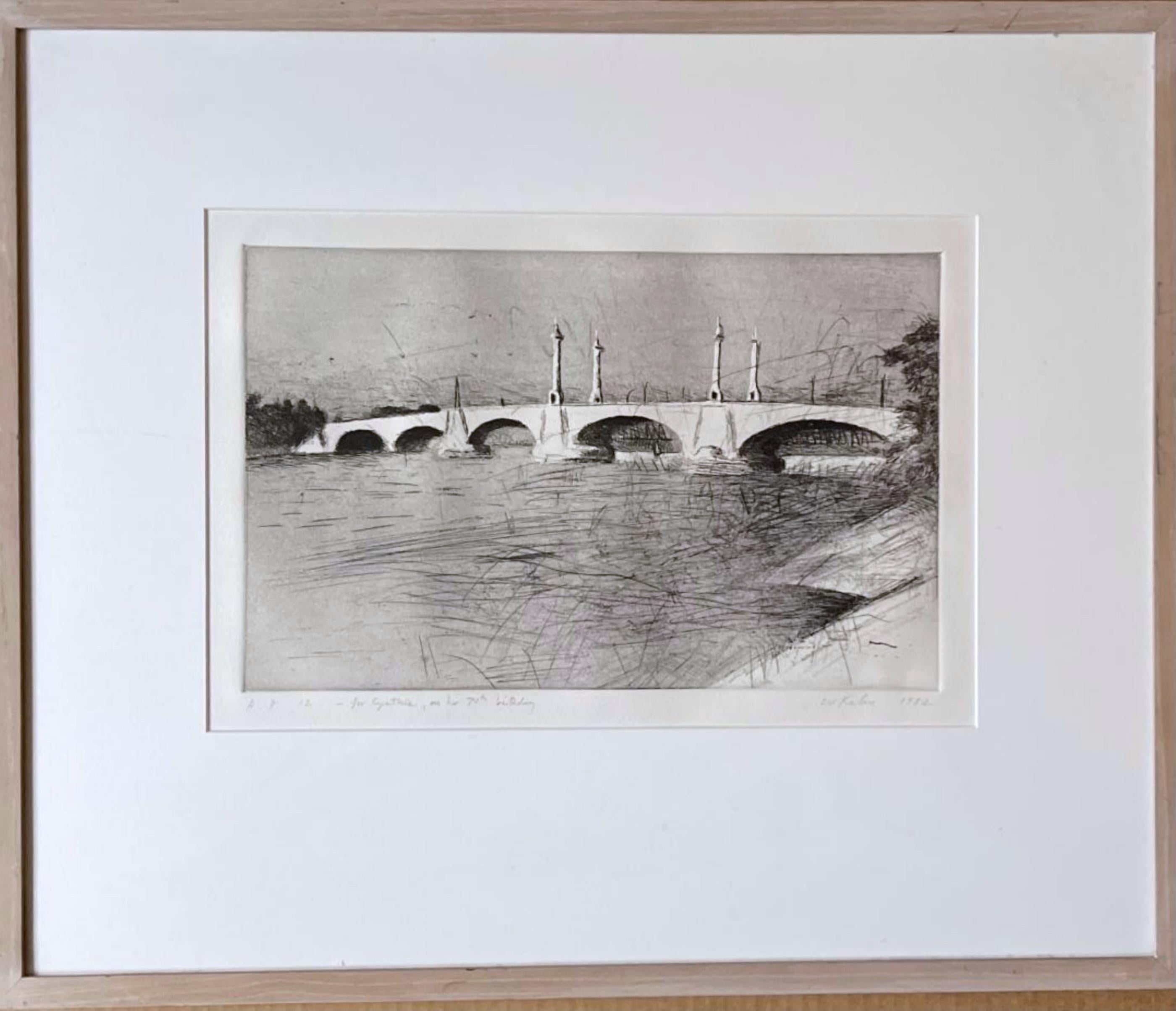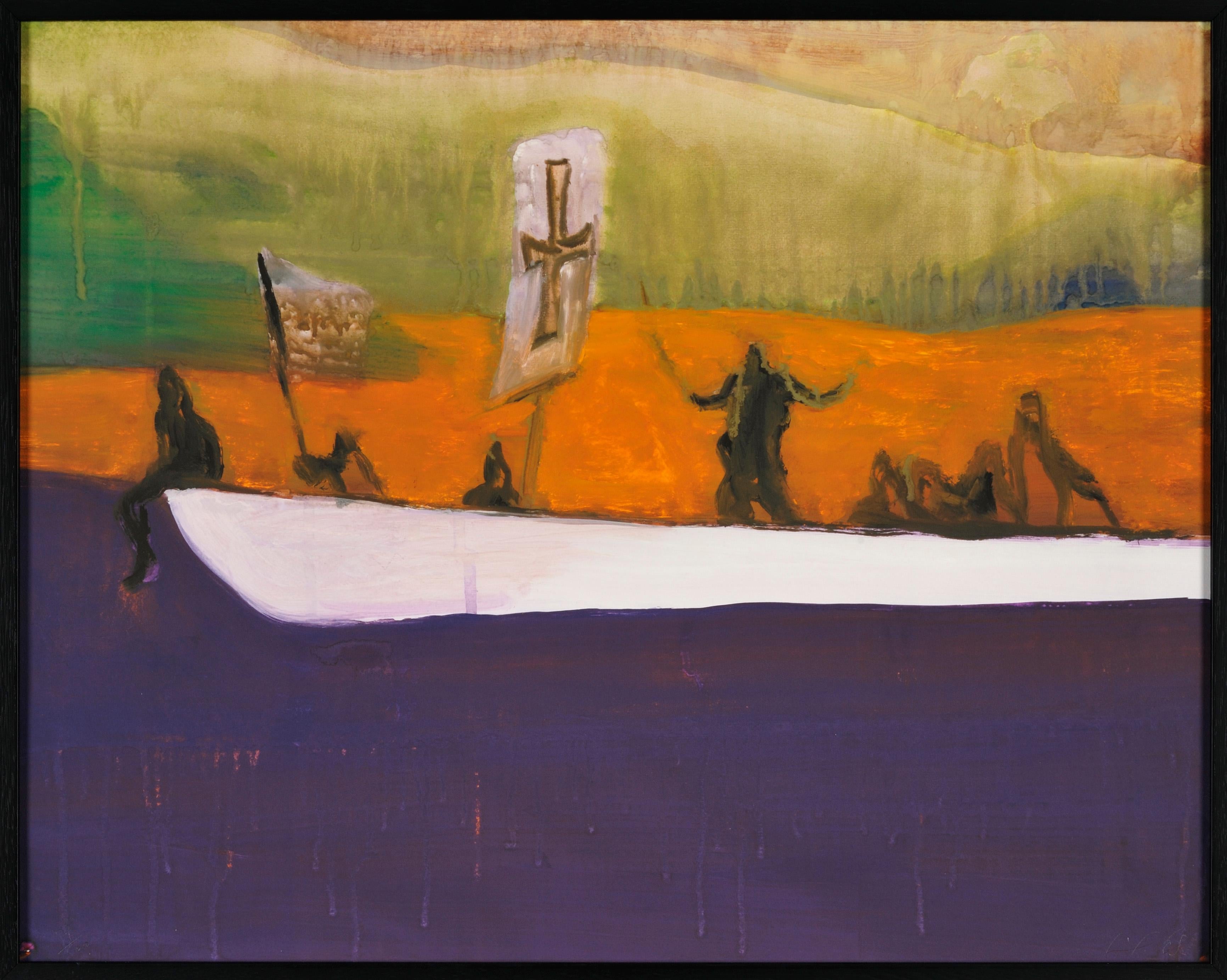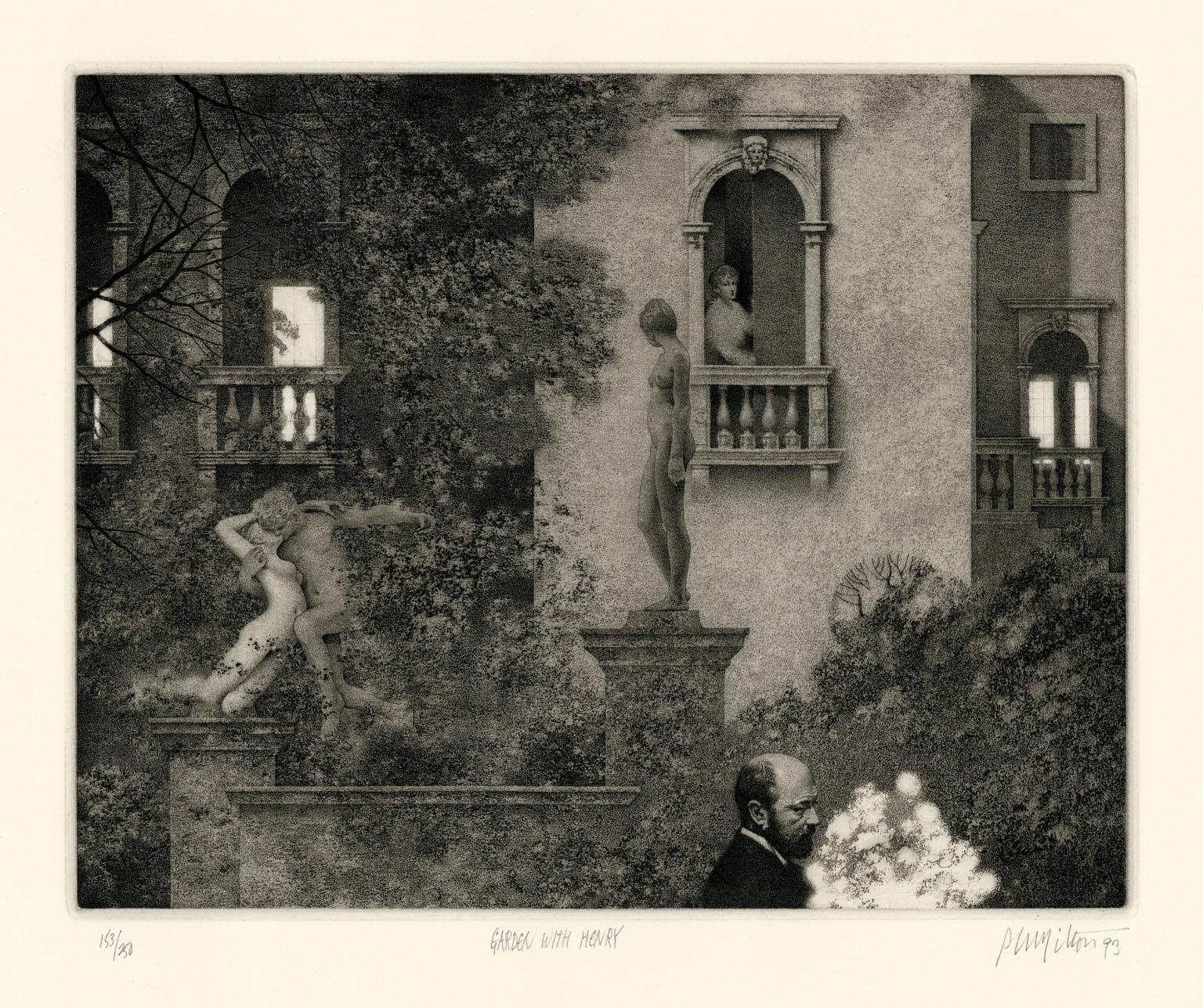Items Similar to Agony - The architecture of decay -
Want more images or videos?
Request additional images or videos from the seller
1 of 8
Jörg OlbergAgony - The architecture of decay -1987
1987
About the Item
Jörg Olberg (*1956 Dresden), Agony, 1987. etching, E.A. (edition of 30), 24 x 17 cm (image), 46 x 37 cm (sheet), each signed in pencil lower right "Olberg" and dated "IX [19]87", inscribed lower left "E.A. [Epreuve d'Artiste]".
- minimal crease and dust stains in the broad margin
- The architecture of decay -
About the artwork
Jörg Olberg draws here the sum of his artistic study of the Berlin ruins, which were still present in the cityscape well into the 80s. With his work "Agony" he creates an allegory of decay. Positioned in the landscape of ruins, a ruined house grows before the viewer, rising like the Tower of Babel into the sky, its roof and gable brightly illuminated by the sun. But already the roof shows mostly only the rafters, and as the gaze is drawn further down, the building visibly disintegrates, the beams protruding in all directions looking like splintered bones. Slowly but inexorably - in agony - the house will collapse in on itself and become nothing more than the burial mound of itself. At the same time, the small-scale stone composition and the plaster form a pattern-like ornamentation of decay.
The tension in the picture is fed by the counter-movement of growth and collapse, which is heightened by the dramatic formation of clouds. The swirls of clouds are reminiscent of a world landscape, such as Albrecht Altdorfer's Battle of Alexandria (1529). And the ruin - this is the further allegorical content - stands pars pro toto for the world as such. In this way, Olberg creates a modern memento mori in an architectural language of forms that is a key work of his early oeuvre.
About the artist
Born in Dresden, Germany, Jörg Olberg trained as a goldsmith, studied architecture in Weimar, and graphic design at the Kunsthochschule Berlin-Weißensee. Since graduating in 1986, he has worked as a freelance artist in Berlin. Throughout his career, Olberg has focused on Berlin's urban landscape, and in his early work he was fascinated by the ruinous side of the city that still existed in the 1980s.
GERMAN VERSION
Jörg Olberg (*1956 Dresden), Agonie, 1987. Radierung, E.A. (Auflage 30 Stück), 24 x 17 cm (Darstellung), 46 x 37 cm (Blattgröße), jeweils in Blei unten rechts mit „Olberg“ signiert und mit „IX [19]87“ datiert, unten links als „E.A. [Epreuve d'Artiste]“ bezeichnet.
- minimale Knick- und Staubspuren im breiten Rand
- Die Architektur des Verfalls -
zum Kunstwerk
Jörg Olberg zieht hier gleichsam die Summe seines künstlerischen Studiums der Berliner Ruinen, die noch bis weit in die 80er Jahre hinein im Stadtbild präsent waren. Mit seinem Werk „Agonie“ schafft er eine Allegorie des Verfalls. In der Schuttlandschaft positioniert, wächst vor dem Betrachter ein ruinöses Haus empor und ragt – wie der Turmbau zu Babel – in den Himmel hinein, wo das Dach und der Giebel hell von der Sonne beschienen werden. Aber bereits das Dach zeigt größtenteils nur noch die Sparren und wird der Blick weiter nach unten geführt, löst sich das Gebäude zusehends auf, wobei die in alle Richtungen ragenden Balken wie gesplitterte Knochen wirken. Langsam aber unaufhaltsam – in Agonie – wird das Haus in sich zusammenstürzen und nur noch den Grabhügel seiner selbst ausmachen. Dabei bilden der kleinteilige Steinverbund und der Putz eine musterförmige Ornamentalität des Verfalls.
Aus der Gegenbewegung von Aufwachsen und Einstürzen speist sich die Bildspannung, die von der dramatischen Wolkenbildung noch gesteigert wird. Die Wolkenwirbel gemahnen an eine Weltlandschaft, wie sie mit Albrecht Altdorfers Alexanderschlacht (1529) vor Augen steht. Und die Ruine – dies ist der weitergehende allegorische Gehalt – steht pars pro toto für die Welt als solche ein. Damit schafft Olberg ein modernes memento mori in architektonischer Formensprache, das ein Schlüsselwerk seines frühen Oeuvres darstellt.
zum Künstler
Gebürtig aus Dresden absolvierte Jörg Olberg eine Goldschmiedelehre und ein Architekturstudium in Weimar und studierte anschließend Grafikdesign an der Kunsthochschule Berlin-Weißensee. Seit dem Abschluss 1986 ist er in Berlin freiberuflich als Künstler tätig. Über sein Oeuvre hinweg widmet sich Olberg der Berliner Stadtlandschaft, wobei ihn in seinem Frühwerk die in den 80er Jahre immer noch präsente ruinöse Seite Berlins faszinierte.
- Creator:Jörg Olberg (1956, German)
- Creation Year:1987
- Dimensions:Height: 18.12 in (46 cm)Width: 14.57 in (37 cm)Depth: 0.4 in (1 cm)
- Medium:
- Movement & Style:
- Period:
- Condition:
- Gallery Location:Berlin, DE
- Reference Number:1stDibs: LU2438212340722

About the Seller
5.0
Vetted Seller
These experienced sellers undergo a comprehensive evaluation by our team of in-house experts.
Established in 2014
1stDibs seller since 2023
7 sales on 1stDibs
Typical response time: 7 hours
- ShippingRetrieving quote...Ships From: Berlin, Germany
- Return PolicyA return for this item may be initiated within 14 days of delivery.
More From This SellerView All
- View of a coastal town / - The Pilgrim's View -Located in Berlin, DEAlbert Ernst (1909 Fronhofen - 1996 Hamburg), View of a Coastal Town, etching, 30 x 37 cm (picture), 45 x 50.5 cm (frame), signed in pencil lower right "Albert Ernst", framed under g...Category
Mid-20th Century Realist Landscape Prints
MaterialsEtching
- The Lost TraceBy Ernst FuchsLocated in Berlin, DEErnst Fuchs (1930 Vienna - 2015 ibid), The Lost Trace, 1972. Vernis mou and aquatint etching, 46.8 x 36.4 cm (plate), 66 x 50 cm (sheet), 69.5 x 53.5 cm (frame), WVZ Hartmann no. 185...Category
1970s Surrealist Figurative Prints
MaterialsEtching
- Evening - The depth of the visible -Located in Berlin, DEMax Clarenbach (1880 Neuss - Cologne 1952), Evening. Etching, 18 x 41 cm (platemark), 33.5 x 57 cm (frame), inscribed "Abend" in pencil at lower left, signed and dated "M. Clarenbach. 28.III.[19]09". Framed and mounted under glass. - Somewhat browned and slightly foxed. About the artwork The horizontally elongated etching depicts the panoramic view of a small town as seen from the other side of the river. There are gabled houses on the left and a mighty church spire on the right. The bourgeois houses and the large religious building indicate the urban character. These buildings are rendered in dark tones to emphasise the lighter row of houses in the centre of the picture, closer to the water. The chiaroscuro contrast creates two parallel planes that open up a space for the imagination of what the city could be. The imagination is stimulated by the almost entirely dark, barely recognisable buildings, while the arm of the river leading into the city further stimulates the imagination. However, as the silhouette of the city as a whole is reflected in the water, the parallel planes are perceived as a band of houses that stretches across the entire horizontality of the etching and seems to continue beyond the borders of the picture. The reflection has almost the same intensity as the houses themselves, so that the band of buildings merges with their reflection to form the dominant formal unit of the picture. Only the parallel horizontal hatching creates the convincing impression of seeing water, demonstrating Max Clarenbach's mastery of the etching needle. The water is completely motionless, the reflection unclouded by the slightest movement of the waves, creating a symmetry within the formal unity of the cityscape and its reflection that goes beyond the motif of a mere cityscape. A pictorial order is established that integrates everything in the picture and has a metaphysical character as a structure of order that transcends the individual things. This pictorial order is not only relevant in the pictorial world, but the picture itself reveals the order of the reality it depicts. Revealing the metaphysical order of reality in the structures of its visibility is what drives Clarenbach as an artist and motivates him to return to the same circle of motifs. The symmetry described is at the same time inherent an asymmetry that is a reflection on art: While the real cityscape is cut off at the top of the picture, two chimneys and above all the church tower are not visible, the reflection illustrates reality in its entirety. The reflection occupies a much larger space in the picture than reality itself. Since antiquity, art has been understood primarily as a reflection of reality, but here Clarenbach makes it clear that art is not a mere appearance, which can at best be a reflection of reality, but that art has the potential to reveal reality itself. The revealed structure of order is by no means purely formalistic; it appears at the same time as the mood of the landscape. The picture is filled with an almost sacred silence. Nothing in the picture evokes a sound, and there is complete stillness. There are no people in Clarenbach's landscape paintings to bring action into the picture. Not even we ourselves are assigned a viewing position in the picture, so that we do not become thematic subjects of action. Clarenbach also refrains from depicting technical achievements. The absence of man and technology creates an atmosphere of timelessness. Even if the specific date proves that Clarenbach is depicting something that happened before his eyes, without the date we would not be able to say which decade, or even which century, we are in. The motionless stillness, then, does not result in time being frozen in the picture, but rather in a timeless eternity that is nevertheless, as the title "Abend" (evening), added by Clarenbach himself, makes clear, a phenomenon of transition. The landscape of the stalls is about to be completely plunged into darkness, the buildings behind it only faintly discernible. The slightly darkened state of the sheet is in keeping with this transitional quality, which also lends the scene a sepia quality that underlines its timelessness. And yet the depiction is tied to a very specific time. Clarenbach dates the picture to the evening of 28 March 1909, which does not refer to the making of the etching, but to the capture of the landscape's essence in the landscape itself. If the real landscape is thus in a state of transition, and therefore something ephemeral, art reveals its true nature in that reality, subject to the flow of phenomena, is transferred to an eternal moment, subject to a supra-temporal structure of order - revealed by art. Despite this supratemporality, the picture also shows the harbingers of night as the coming darkening of the world, which gives the picture a deeply melancholy quality, enhanced by the browning of the leaf. It is the philosophical content and the lyrical-melancholic effect of the graphic that give it its enchanting power. Once we are immersed in the image, it literally takes a jerk to disengage from it. This etching, so characteristic of Max Clarenbach's art, is - not least because of its dimensions - a major work in his graphic oeuvre. About the artist Born into poverty and orphaned at an early age, the artistically gifted young Max Clarenbach was discovered by Andreas Achenbach and admitted to the Düsseldorf Art Academy at the age of 13. "Completely penniless, I worked for an uncle in a cardboard factory in the evenings to pay for my studies.” - Max Clarenbach At the academy he studied under Arthur Kampf, among others, and in 1897 was accepted into Eugen Dücker...Category
Early 1900s Realist Landscape Prints
MaterialsEtching
- Three Herons - At the flaming lake -Located in Berlin, DERudolf Hayder (active in the 1st half of the 20th century), Heron. Color woodcut on thin Japanese paper, 24 x 29 cm (image), 29 x 36 cm (sheet size), signed by hand at lower right "R. Hayder" and titled by hand as "Reiher". Lower left inscribed by hand "Orig.[inal] woodcut, hand print". - A little bit stained in the margins and very occasionally in the image, minimal hole above the signature, traces of creasing. At the back side's margins with remnants of an old mounting. About the artwork In the context of French Japonism, the color woodblock print, which was widespread in the Asian region, was rediscovered for Western art. The artists of the time, such as Édouard Manet, Claude Monet, Edgar Degas, Paul Gauguin and Vincent van Gogh, were inspired not only by the cultural influence, but also by the two-dimensionality of the pictorial spaces. Thus, color woodcuts became an important moment in the development of the modern pictorial concept founded by Impressionism. In Rudolf Hayder's "Herons", too, the two-dimensionality of the pictorial space is decisive for the pictorial effect. The herons, surrounded by reeds, are framed by the yellow background of the lake, followed by the dark blue-greenish stripe of the opposite shore and, above it, the sky in a lighter blue-green. Formally, it is a sequence of planes, but the two-dimensionality of the motif creates a spatial effect. This spatiality in the surface creates an intense pictorial effect. Hayder intensifies this effect with the blazing lake. In terms of color, the water becomes a sunset. The yellow turns reddish brown toward the shore, then fades to brownish red, while the shore is a watery turquoise...Category
Early 20th Century Realist Animal Prints
MaterialsColor
- Balaclava - The target in sight -Located in Berlin, DEHeinrich Haberl (1869 Passau to 1934 Munich), Sturmhaube, c. 1900. drypoint, 14 x 10 cm (platemark), 28 x 21 cm (sheet size), 39 x 29 cm (passe-partout), titled "Sturmhaube" in lead at lower left and inscribed "Kaltnadelradierung", signed and locally inscribed "Heinrich Haberl Mchn. [Munich]" at lower right, inscribed again in lead on verso and with old collection stamp. - slightly darkened, fixed and mounted - The target in sight - About the artwork The theatrical "role-portrait" is to be seen against the background of the Rembrandt cult, which reached its climax at the end of the 19th century. The soldier seems to have stepped straight out of Rembrandt's Night Watch (1642) to fix something outside the picture with an alert and ready gaze. The steeply rising brim of the morion frames the gaze and thus perspectivises it as the actual 'pictorial action'. The gaze represents both the vigilant defence and the visionary goal of the battle. Not only the subject, but also the style of the etching needle reflect Rembrandt's understanding of the times. Strong contrasts of light and dark are created in a virtuoso free stroke, without losing the effect of the reflections on the helmet and in the eyes. This shows a kinship with the early prints of Lovis Corinth, who also saw himself as an artist in the role of the knight. Against this background, Haberl's picture can also be seen as a representation of his artistic self-image. About the artist Heinrich Haberl first attended the art school in Nuremberg and from 1892 studied at the Munich Academy. There he was a master student of Johann Leonhard von Raab, Rudolf von Seitz, Franz von Defregger...Category
Early 19th Century Realist Figurative Prints
MaterialsEtching
- The Talisman (so called Dukatenscheisser) - The philosopher's stone -By Carl PlückebaumLocated in Berlin, DECarl Maria Plückebaum (1880 Düsseldorf - 1952 ibid.), Der Talismann (sog. Dukatenscheisser), partly colored etching, 11.5 x 8.5 cm (plate size), 26.5 x 20 cm (sheet size), signed by hand below the image on the right "C. Plückebaum" and inscribed by hand at lower left "Der Talismann". - left and right side of the sheet with browned stripes, otherwise good copy - The philosopher's stone - About the artist Here, Carl Plückebaum gives free rein to his anti-academic impulses and turns the subtle humor of his pictures into crudeness. Following Adrian Ostade's peasants as they go about their needy business, we see a cowardly fellow in a squatting position. His excrement, however, is not the organic remains of digestion, but - like the golden donkey in the Grimm fairy tale - ducats. However, they appear more brown than golden, which is emphasized by the discreet hand-coloring of the picture. The unattractive accumulation is countered by the blossoms decorating the crouching man's hat. Totally absorbed in his action, his activity is evident in the strained expression on his face, giving Plückebaum a whole new verisimilitude to the concept of naturalism. The title "The Talisman" then turns naturalism back to the miraculous, formulating in a humorous way that these legacies are also a "miracle of nature". About the artist Coming from a poor background, Carl Plückebaum, who had a walking disability and was of short stature, initially worked as a church restorer. He also took private drawing lessons. In 1901 he won the first prize of the Düsseldorf Museum of Decorative Arts, which enabled him to finance his studies at the Düsseldorf Academy. There he was a pupil of Eduard von Gebhardt and Peter Janssen the Elder, but began to doubt the academic teaching. In 1906 he took part in a group exhibition at the Städtische Kunsthalle Düsseldorf, which violated the academy's statutes and led to his dismissal. However, the extraordinary success with the public confirmed him as an artist and provided him with the financial means for a study trip to Italy. Enchanted by Florence, he retired to the Franciscan monastery of Fisole, where he worked as a fresco painter. Back in Düsseldorf, he turned increasingly to children's and animal drawings, and in 1907 he was a founding member of the Niederrhein Secessionist Artists' Group. In 1910 he travelled to Italy again, accompanied by his painter friends Walter Ophey and Carl Schmitz-Pleis, visiting Rome and Naples in particular. He then stayed in Munich to study the Old Masters at the Pinakothek. It was in the artistic circles of Schwabing that he met his future wife, the painter Meta Weber. In Düsseldorf, Carl and Meta Plückebaum...Category
Early 20th Century Realist Figurative Prints
MaterialsEtching
You May Also Like
- Cyril's Bay - Peter Doig, Contemporary, 21st Century, Magic Realism, EditionBy Peter DoigLocated in Zug, CHCyril's Bay - Peter Doig, Contemporary, 21st Century, Magic Realism, Limited Edition Digital pigment print with silkscreen varnish on Somerset Velvet 255gsm with hand torn edges Edit...Category
Early 2000s Realist Figurative Prints
MaterialsEtching
- The Whitney (Marcel Breuer Building)By Richard HaasLocated in New York, NYRichard Haas The Whitney (Marcel Breuer Building), 1979 Woodcut engraving Signed, titled, dated and numbered by the artist on the back. This is a rare Artist Proof 9/10, aside from the regular edition of 60. 22 3/4 × 18 1/4 inches Unframed This vintage 1979 woodcut engraving by the world's top architectural muralist and trompe d'oeil artist, Richard Haas, depicts the building New Yorkers nostalgically call the "Old Whitney". Long before the Whitney moved to Manhattan's trendy meatpacking district...Category
1970s Realist Figurative Prints
MaterialsEngraving, Etching
- Hong KongBy Richard HaasLocated in New York, NYRichard Haas Hong Kong, 1990 Etching and Aquatint on wove paper Hand Signed, numbered and dated on the front Frame included; held in the original vintage hand made wood frame done by PSG This impressive, framed lithograph of Hong Kong is by Richard Haas - the world's foremost architectural muralist and trompe l'oeil artist whose prints and paintings are held and exhibited in many private, public and institutional collections. It is framed and ready to hang. Haas - who, aside from his many artistic distinctions, was profiled several years back by the prestigious CBS News...Category
1990s Realist Figurative Prints
MaterialsEtching, Aquatint
- Memorial Bridge, Springfield, MassBy Wolf KahnLocated in New York, NYWolf Kahn Untitled, 1982 Original Etching 10 × 15 inches Edition AP (aside from the regular edition of 90) pencil signed, dated and inscribed to Cynthia Frame included: Ships framed...Category
1980s Realist Landscape Prints
MaterialsEtching
- Canoe - Peter Doig, Contemporary, 21st Century, Etching, Magic Realism, EditionBy Peter DoigLocated in Zug, CHCanoe - Peter Doig, Contemporary, 21st Century, Etching, Magic Realism, Limited Edition Edition of 500 Signed and numbered, accompanied by Certificate of Authenticity In mint conditi...Category
Early 2000s Realist Figurative Prints
MaterialsEtching
- Garden with HenryBy Peter MiltonLocated in New York, NYPeter Milton created this etching and engraving entitled “GARDEN WITH HENRY” in 1993. It is signed, titled, dated, and inscribed “153/250” in pencil under the image. The printed image size is 9.5 x 12 inches and the paper size is 15.5 x 18 inches. The inspiration for this piece came from the Henry James novella “The Aspern Papers” and clearly depicts the Venetian setting. The American-British author Henry James (1843-1916) wrote “The Aspern Papers” first published in 1888. Peter Milton was born in Pennsylvania in 1930. He studied for two years at the Virginia Military Institute...Category
1990s Realist Landscape Prints
MaterialsEngraving, Etching
Recently Viewed
View AllMore Ways To Browse
Toto Vintage
Rolex Cold
Stanley Roberts Cycle
Tete D Terre
Tiffany And Co Palm Beach Fl
Tiffany And Co Singapore
W D Sadler Prints
William Henry Fisk
Canvas Painted Draft Screen
Fat Princess
Glass Live Tree Murano
His And Her Rolex
His Her Rolex
John C Rinker
Kosta Boda Face Goblet
Orient Express Vintage Poster
Retro Japanese Lunch Box
Silent Stump
